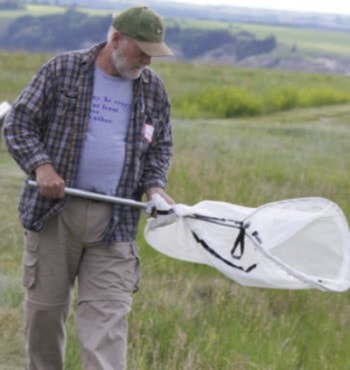Though the sun was frequently hidden by clouds and there was a tiny bit of rain, the annual Dry Island Buffalo Jump Provincial Park butterfly count went well on Sunday, July 6, with 25 species of butterflies and skippers (which are thought of to be an evolutionary transition between moths and butterflies) being observed during the day.
Organizer Charles Bird says he typically gets about 40 participants for the butterfly count, and this year that held true, with 41 participants from as far as Calgary and Edmonton.
The purpose of the count is to document any changes in the butterfly population in the area, and of course, learn about the outdoors.
“This year we had a long, cold spring and that means that we won’t see as many things as we usually do,” Bird said. “People may be a little disappointed – they won’t see the diversity – but it’s nature.”
Participants met in the upper parking lot of the park and received name tags, and some went looking for butterflies there – and found five different species.
The official count began in 1999, though there were unofficial ones prior to that. Since then, it’s gained exposure until it became the significant event that it is today.
“I’m really interested in butterflies and moths and in connection with that, I’ve done quite a bit of research here in this park,” Bird said. “I’ve been able to find over 500 species of moths and 50 or so species of butterflies.”
The group moved down into the park itself just after 10 a.m. Most drove, but some hiked the steep, long trail. After that, participants scattered to find butterflies. They broke for lunch at noon, and discussed natural history topics.
After lunch, the participants divided up into three groups (one of which was led by John Acorn, a.k.a. “Acorn the Nature Nut”) to roam further for butterflies. Near the end of the day, the group examined the caught butterflies and identified them.
“When we’re all done, we find the youngest person in the group, give the bottle to that person, take the lid off, and let the butterfly go,” Bird said. “So it’s catch and release, and the youngsters really have fun doing that.”
Bird estimates that collectively, the group walked at least 10 km. in search of butterflies.
Two species, Lycaena hyllus and Euphyes vestris have not been observed on previous counts. The capture of Euphyes vestris is only the second record of the species from Alberta. The first record occurred near Erskine in 1999. Another species, the Speyeria callippe, was recorded for only the second time at the Dry Island Buffalo Jump count.
Butterflies weren’t the only things that were observed in the wild: wildflowers were in full bloom, including brown-eyed Susans, wild blue flax, and goats’ beard.
